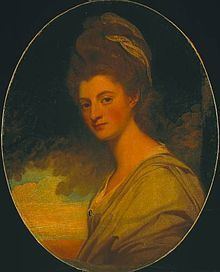Occupation Writer, socialite Role Author Name Elizabeth Craven | Period 1778–1826 Nationality British | |
 | ||
Subject Travel writing, drama, memoirs Died January 13, 1828, Posillipo, Italy Spouse Charles Alexander, Margrave of Brandenburg-Ansbach (m. 1791) Children Maria Molyneux, Countess of Sefton Books The Georgian Princess, Multilingualism and Education: An Annotated Bibliography Parents Elizabeth Drax, Augustus Berkeley, 4th Earl of Berkeley Grandparents James Berkeley, 3rd Earl of Berkeley | ||
Elizabeth Craven (née Lady Elizabeth Berkeley) (17 December 1750 – 13 January 1828), Princess Berkeley (though often styled "Margravine of Brandenburg-Ansbach"), previously Lady Craven, of Hamstead Marshall, was an author and playwright, perhaps best known for her travelogues. She was the third child of the 4th Earl of Berkeley, born in Mayfair in the West End of London.
Contents
Works
Early in her literary career she wrote a number of light farces, pantomimes, and fables, many of which were performed in London to no great acclaim. She knew Samuel Johnson and James Boswell, and became a close friend of Horace Walpole, who published her early works which, with later efforts, include:
Very few of her musical compositions survive:
Personal life
Her life was full of scandal: after thirteen years of marriage, seven children, and affairs reported on both sides, she and her first husband, William Craven, 6th Baron Craven, (married since 30 May 1767), parted permanently in 1780. Thereafter she lived in France and travelled extensively on the Continent.
For a number of years she maintained a romantic relationship with Charles Alexander, Margrave of Brandenburg-Ansbach. His wife since 1754, Princess Friederike of Saxe-Coburg-Saalfeld, died in Germany on 18 February 1791, and Lady Craven's husband died in Lausanne on 26 September 1791. The couple then married in Lisbon on 30 October 1791 and settled in England. While the Margravine was snubbed by ladies mindful of their reputations, as well as by her latest husband's cousin, King George III himself, and as well as by Queen Marie-Antoinette when she visited France, the couple lived a full and opulent life in Hammersmith, London, and Benham Park at Speen in Berkshire.
Nonetheless, Elizabeth was never legally entitled to share her husband's German rank and title: on 20 February 1801, she was granted the morganatic title of "Princess (Fürstin) Berkeley" by the last Holy Roman Emperor, Francis II. In fact, Charles Alexander, being the last of his cadet branch of the House of Hohenzollern, and childless, had exchanged his hereditary birthright to the appanages of Ansbach and Bayreuth for an annuity of 300,000 guilders from his pater familias, King Frederick William II of Prussia, a month after his second marriage. In England, however, the couple were usually known as the "Margrave and Margravine of Brandenburg-Ansbach".
After Charles Alexander's death at Benham Park in 1806, Elizabeth moved to Naples. She died at Craven Villa in Posillipo and was buried in 1828 in the English Cemetery at Naples. Her links with the Hammersmith area are commemorated in the name of two roads in the area – Margravine Gardens and Margravine Road. There is a wall monument by Roubiliac to her in St Mary's Church, Scarborough.
